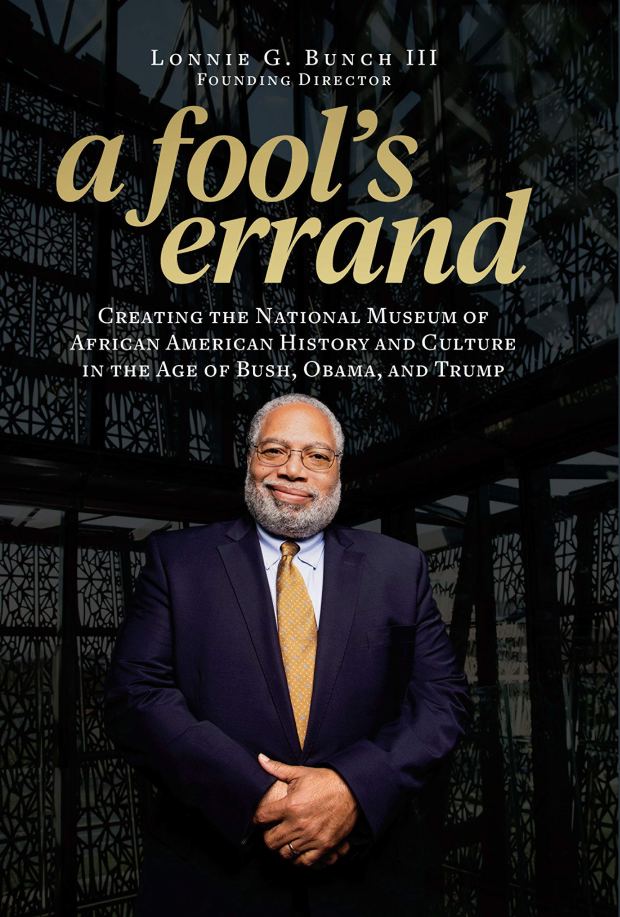BOOK REVIEW: A FOOL’S ERRAND: CREATING THE NATIONAL MUSEUM OF AFRICAN AMERICAN HISTORY AND CULTURE IN THE AGE OF BUSH, OBAMA, AND TRUMP
“One can tell a great deal about a country by what it remembers. By what graces the wall if its museums.” – Lonnie G. Bunch III
The day I finished reading A Fool’s Errand: Creating the National Museum of African American History and Culture in the Age of Bush, Obama, and Trump by Lonnie G. Bunch III, founding director of the Smithsonian’s National Museum of African American History and Culture (NMAAHC), I learned that a school board in Tennessee banned the teaching of the holocaust graphic novel Maus and a House committee in Florida passed a bill aiming to ban discussions of sexual orientation and gender identity in schools. Throughout A Fool’s Errand Bunch notes the friendship he formed with Emmett Till’s mother, Mamie Till-Mobley, and I couldn’t help but to think of the marker outside of Glendora, Mississippi, where Emmett Till’s body was found in 1955. Until 2008, the spot remained unmarked, but when a memorial was erected, it was vandalized four times. The most recent iteration of the memorial, erected in 2019, had to literally be bulletproofed. The parallels to the Till Memorial and the obstacles Bunch faced and the overall history of the museum’s founding are palpable. Bunch notes that efforts to launch this museum started a century prior, and were still being stifled as recent as the 1990s by the likes of Jesse Helms. Silencing the voices of history is bigotry’s fundamental move toward enacting racism.
A Fool’s Errand is framed by three presidents. First, there was George W. Bush, who wholeheartedly endorsed the project and signed the legislation to get it started. Bunch formed a friendship with George and Laura Bush and portrays them rather positively. While he acknowledges Hurricane Katrina, he does so, in my opinion, with a rather light touch. Second was Barack Obama, who had the honor of officially opening the museum. Bunch compares his philosophy of the museum to the way Obama approached his presidency: the museum is an American museum for all Americans and not just African Americans. The story of African Americans is the story of America. And finally, Trump. Bunch describes giving him a private tour, which he rightfully did not bowdlerize as he had been asked to (because Trump had been in a bad mood that day) and noted that Trump did not acknowledge the Dutch role in the African slave trade but conveyed that the people of the Netherlands “love him.” Right on brand. Bunch describes how during the first months of Trump’s administration a noose had been found in front of an exhibition case that contained artifacts of the Ku Klux Klan in the 1920s. As I read the last two chapters, I couldn’t help but wonder if the museum would have opened when it did had Bunch not been so determined in his vision and execution. He worked hard to make this museum “for the next century and not the last one” happen. The politics surrounding this museum is nearly breathtaking but not unexpected.
The book is indeed a template for creating a museum from nothing, but what makes it so incredibly relatable is its humanity. Bunch is an excellent listener and observer and can easily connect with the elite as well as everyday people. For me, it was his interactions with everyday people that stood out. There was Princy Jenkins who had once lived in a slave cabin with his enslaved grandmother; the people he met during Save Our African American Treasures; and Dr. Charles Blockson who donated previously unknown artifacts that belonged to Harriet Tubman. Blockson lovingly donated those items and like many after him, wanted to contribute to the museum without any monetary gain (“This belongs in a place where the public can enjoy the collections. It is yours.”) Perhaps the most moving story was when Bunch met an elderly woman who had an unknown artifact from his own family.
I recommend you read this touching book with an open mind and a very open heart. If you enjoy storytelling and history, you will find a great deal to enjoy in this book. For me, the book inspired a self-reflection of the last two decades. Could I have done better? Can I still do better? I hope so.
